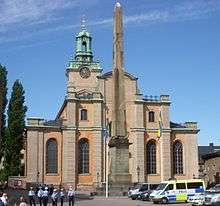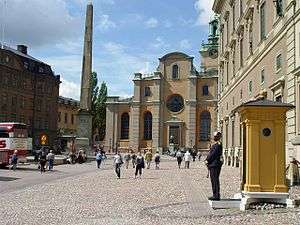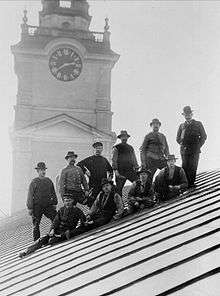Storkyrkan
| Storkyrkan | |
|---|---|
 | |
| Coordinates: 59°19′33″N 18°04′14″E / 59.32583°N 18.07056°E | |
| Location | Stockholm |
| Country | Sweden |
| Denomination | Church of Sweden |
| Previous denomination | Catholic Church |
| Website | Website of the Cathedral |
| History | |
| Founded | 13th century[1] |
| Administration | |
| Diocese | Diocese of Stockholm |
| Clergy | |
| Bishop(s) | Eva Brunne |
Storkyrkan (Swedish: [²stuːrɕʏrkan], The Great Church), officially named Sankt Nikolai kyrka (Church of St. Nicholas) and informally called Stockholms domkyrka (Stockholm Cathedral), is the oldest church in Gamla stan, the old town in central Stockholm, Sweden.[2] It is an important example of Swedish Brick Gothic. Situated next to the Royal Palace, it forms the western end of Slottsbacken, the major approach to the Royal Palace, while the streets Storkyrkobrinken, Högvaktsterrassen, and Trångsund passes north and west of it respectively. South of the church is the Stockholm Stock Exchange Building facing Stortorget and containing the Swedish Academy, Nobel Library, and Nobel Museum.
History
Storkyrkan was first mentioned in a written source dated 1279 and according to tradition was originally built by Birger Jarl, the founder of the city itself. For nearly four hundred years it was the only parish church in the city, the other churches of comparable antiquity originally built to serve the spiritual needs religious communities (e.g., Riddarholm Church). It became a Lutheran Protestant church in 1527. The parish church since the Middle Ages of the Nikolai parish, covering the whole island on which the Old Town stands, it has also been the cathedral of Stockholm since the Diocese of Stockholm was created out of the Archdiocese of Uppsala and the Diocese of Strängnäs in 1942. Because of its convenient size and its proximity to the earlier royal castle and the present royal palace it has frequently been the site of major events in Swedish history, such as coronations, royal wedding and royal funerals. The last Swedish king to be crowned here was Oscar II in 1873. Crown Princess Victoria, oldest daughter of King Carl XVI Gustaf and Queen Silvia, was married to Daniel Westling on 19 June 2010 at the Storkyrkan, the same date on which her parents were also married in Storkyrkan in 1976.
Interior
The most famous of its treasures is the dramatic wooden statue of Saint George and the Dragon attributed to Bernt Notke (1489). The statue, commissioned to commemorate the Battle of Brunkeberg (1471), also serves as a reliquary, containing relics supposedly of Saint George and six other saints; Saint Blasius, Saint Germanus, Saint Leo, Saint Martinus, Saint Donatus and Saint Cyriacus. A copy from the early 20th century is found on Österlånggatan just south of the church. The Saint George is a symbolic representation of Sten Sture, the dragon is the Danish King Christian I, and the Princess is Sweden.
The church also contains a copy of the oldest known image of Stockholm, the painting Vädersolstavlan ("The Sun Dog Painting"), a 1632 copy of a lost original from 1535. The painting was commissioned by the scholar and reformer Olaus Petri, a 19th-century statue of whom is found on the eastern side of the church. It depicts a halo display, e.g. sun dogs, which gives the painting its name and in the 16th century was interpreted as a presage.
The monumental pulpit is the work of Burchard Precht in 1698-1702 and is in a French Baroque style. It became the model for a number of other large pulpits in Sweden. From the rear of its lofty sounding board issues widely billowing dragery, in front of which hover two large winged genii on either side of a radiant sun bearing the Hebrew letters יהוה. The relief on the front of the pulpit itself depicts the story of the Canaanite woman (Matthew 15:21-28). The door of the pulpit is adorned with a relief of Christ's head, while its pediment is crowned by a statue of Hope with putti on either side. Below the memorial are the arms of the Funck family who bore the greater cost of the pulpit. Beneath the pulpit and surrounded by an iron railing lies the worn gravestone of Olaus Petri.[3]
The view down the central aisle of the church is dominated on either side by the Royal Pews, one facing the other on either side of the central aisle. They were designed by the celebrated architect Nicodemus Tessin the Younger and made by Butchard Precht. Each consists of a large enclosed box with decorated sides and back. High above each of the Royal Pews is a large royal crown forming a canopy above it, supported by two genii in flowing mantles, and from which billow sculptured hangings behind the royal seat, while above hover numerous putti. The royal seats are themselves upholstered in blue velvet with rich applied embroidery.
The main altar--"The Silver Altar"—is a wooden triptych with an ebony veneer with sculptured reliefs in silver in ascending order of the Last Supper on the predella; a large depiction of the Crucifixion of Christ between silver statues of Moses and John the Baptist in niches with small silver columns on either side; of the Burial of Christ (between silver statues of the evangelists Matthew and Mark; of Christ's Harrowing of Hell (between statues of the evangelists John and Luke; and on the pediment at top of the triptych, a silver statue of the Risen Christ between two reclining soldiers.
On either side of the Silver Altar is a sculpture holding a candle, one of St. Nicholas (the patron of the church) and the other of St. Peter, both designed by G. Torhamn and carved in oak by the sculptor Herbst in 1937. The rose window above and behind the Silver Altar was made in Paris in the 1850s, the first of a series of modern stained windows in the church contributed by various donors. The Silver Altar and the rose window above it fill the wall space formerly occupied by the apse of the medieval chancel removed by Gustavus Vasa when he expanded the fortifications of the Tre Kronor Castle, while the statue of the Olaus Petri monument at the back exterior of the church stands on the site of the medieval high altar.
Gallery
 Storkyrkan, close-up of its tower
Storkyrkan, close-up of its tower Storkyrkan as viewed from Storkyrkobrinken
Storkyrkan as viewed from Storkyrkobrinken Eastern façade facing the Stockholm Palace and Slottsbacken
Eastern façade facing the Stockholm Palace and Slottsbacken.jpg) St. George and the Dragon
St. George and the Dragon Tinsmiths on the roof of Storkyrkan, 1903.
Tinsmiths on the roof of Storkyrkan, 1903.
See also
References
- ↑ "Storkyrkan". Nationalencyklopedin (in Swedish). Retrieved 28 August 2011. (subscription required)
- ↑ Storkyrkan in the Old Town, Stockholm
- ↑ The Latin inscription reads: "Here rests the worthy man Master Olaus Petri, the servant of the Gospel and Pastor of Stockholm's Church, who died in the year of Our Lord 1552. After darkness, I hope for light. Rom. 1" (translation by Edward Adams-Ray).
External links
| Wikimedia Commons has media related to Storkyrkan, Stockholm. |